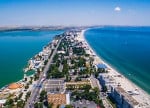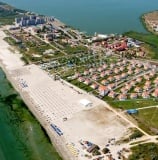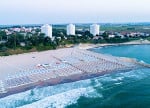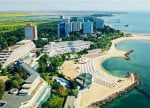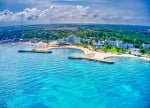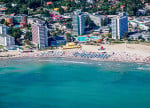Recreation on seaside
Seaside Transportation
Transportation, inland and exterior, information about transportation on seaside...
See detailsSeaside tourist attractions
See the most important tourist attractions on the Romanian Coast
Tourist spotsConstanta
The Aquarium Constanta
The Aquarium is located on the seafront, right in front of the imposing Casino. Opened with great fanfare on 1st of May 1958, Constanta's Aquarium was for a long time the first and only public institution of its kind in our country. The building that hosts the aquarium was built in the early twentieth century as an annex to the Casino and functioned as a restaurant, and destinatined to its current redevelopment. The Aquarium exhibition spaces are intended to describe the permanent exhibition of aquatic fauna and flora, and some temporary exhibitions on various topics related to biology, ecology, aquatic and marine fisheries.
Along tim...
St. Mary Armenian Church
The Armenian Church of Constanta is dedicated to "Saint Mary" and is situated on the seashore, near the Greek Church,on Callatis street. Less known by tourists, perhaps because the building stands out through a spectacular architecture, theArmenian Church embodies Armenian people living on Doborogea area is a important poin on the multiculturalism map of Constanta. The first Armenians arrived in Dobrogea in the XVth century, settling the administration center in Babadag, then the Ottomans ruled the land between the sea and the Danube. Armenians came much later in Constanta, and according to historical notes, in...
Metamorphosis Greek Church
The Greek Church "Metamorphosis" is a small sanctuary located in the historical area of the city, on Mircea cel Batran street, close to the Modern beach. The story fo the beautiful church began half a century ago, back when Dobrogea was part of the Ottoman Empire, and marked "birth" of the first Christian place of worship in Constanta. The building was started in 1862 with the consent of the Sultan Mehmet Han Bin Abdul Aziz who responded so positively to the request of the Greek community to build a place of worship in the area.
The church building was designed by the Greek ar...
St Anthony Roman-Catholic Church
The Roman-Catholic Church "St. Anthony of Padova" is situated in the historical area of Constanta, close to Carol I Mosque and Cathedral of Saints Peter and Paul. The imposing church was built between 1935-1936 on the site of a former Roman Catholic chapels. The construction drawings were prepared by Roman architect Simon of Bucharest, who set as model the churches in northern Italy. The building, which dominates the landscape of the old city today, is built of red bricks and the architectural point of view it is included in current novels.
The Romanesque style building is distinguished...
St Mina Church
St Mina Church is a great location, being an a oasis of peace of Constanta. The church is located in Tabacariei Park, on the lakeshore with the same name, away from city noise. The beautiful church was built between 1995 - 1997 by the architect Nicolae Goga and respects in the smallest details the traditional style of Maramures. Besides its beauty the church has an impressive height, whose tower measures 43 meters and is visible from many areas of the city. Because of this, the Church "St. Mina" from Constanta takes a well deserved place on the list of highest wooden church in our coun...
Saints Peter and Paul Orthodox Cathedral
The cathedral is dedicated to Saints Peter and Paul and it is the largest and most important Orthodox church in Dobrogea, being known as the Cathedral of the Archbishop of Tomis. The church is situated in the historical area ofthe city, close to the seafront boulevard Elizabeth and the Casino.
Built between 1883 and 1885 was the first Orthodox settlement built in Dobrogea after the realease from Ottoman domination. The church was built of brick and concrete, after the plans of the famous architect Ioan Mincu. The Interior furniture, consisting of veil, pews, chandeliers and candlesticks is genuine and was execute...
The Casino
Always present in the tourists seaside photos and the postcards, Constanta's Casino is arguably the city emblem. An imposing building that exudes the air since his glory days, the Casino "watches" the Black Sea for over 130 years.
The Casino beginning binds Dobrogea to the romanian administration, the first building built on the seashore after the end of the Ottoman domination. More specifically, the first stone of the Casino was laid in 1880. At the time the settlement was located near Genoese lighthouse and was built on wooden structure and the outside was lined with boards. Inside, a dance hall, two game r...
The Dolphinarium
The Dolphinarium is among the most visited tourist attractions in Constanta both in summer and in the off-season. Along The Planetarium and The Astronomical Observatory and the Microreserve, the Dolphinarium is a beautiful and exciting part of the Natural Sciences Museum Complex of Constanta, located on Mamaia Boulevard at the intersection with Soveja street.
The Dolphinarium was inaugurated on June 1st, 1972, representing at that time the first museum of its kind in Romania and South-Eastern Europe. Currently The Dolphinarium remains the only location in our country where you can re...
The Roman Mosaic Edifice
The Roman Mosaic Edifice is located near the Museum of National History and Archaeology and was discovered in 1959 during some civil works undertaken in the Ovidiu Square. Further research discovered that the monument was built in the fourth century and gradually spread until around the sixth century, when it stopped. In its glory times the edifice represent the largest building of its kind in the whole Roman Empire and serve as a link between the port and the ancient city, the place where the conduct its trade and storage of goods. Originally, the building spans three of the four terraces of Tomis harbo...
The Genoese Lightshouse
The Genovese Lighthouse is a monument that can be easily unnoticed, but the beauty and importance to the history of Constanta are undeniable. The Genovese Lighthouse is located on the seafront, between the Casino and the former Carol Hotel (today the Navy Headquartesr).
Despite its name, the monument has nothing in common with the Genoese. In an article on the history of Genoese Lighthouse, published in 2004 in a local newspaper journalist Maria Comanita Cica, notis that: "The Genoese arrived in Constanta port but they have no lighthouse built here. Their reputation as rulers of the se...
Hunchiar Mosque
The Hunchiar Mosque is situated in the historic area of the city, a few steps from the Museum of Traditional Art. This place is not tvery large but has a huge significance for the history and multiculturalism of Constanta being the oldest Muslim religious edifice in the city.
The history documents tell us that at the beginning of the nineteenth century, Constanta, then occupied only the peninsula (now the historic area, almost to the Casino ), was bounded by a defensive wall with bastion built by Turks who ruled Dobrogea at that time. The defensive wall was destroyed between 1828 - 1829, leaving o...
The Gravity Park
The Gravity Park from Constanta is the largest outdoor complex in Romania dedicated to extreme sports. Located on Soveja street, on the southern shore of Lake Tabacarie, the Gravity Park was inaugurated on May 24, 2008 by a show attended by athletes from all over the country. The park has a total area of 8500 square meters and is divided into trial areas, dirt jumping, climbing, bouldering and obviously skate and roller. Besides the tracks, Gravity Park provides its visitors: a Skateshop, internet cafe, locker rooms, showers, equipment rental center and first aid center, and the future pizzeria, terrac...
Lake View Entertainment and Sports Center Constanta
LAKE VIEW ENTERTAINMENT AND SPORTS is a modern entertainment center located on Mamaia Boulevard, near the entrance of Mamaia resort. The center is housed by an imposing building with a futuristic design, divided into 3 floors. The ground floor of Central Lake View a fancy restaurant which continues outside, the lake, with a terrace and a playground is arranged. Also on the ground floor, in the opposite direction the restaurant is a modern hall with over 60 electronic games and table tennis. Lake View has 16 pool tables and 12 bowling lanes, all located on the 1st floor of the building, in a gener...
The Natural Microreserve
The Microreserve of the Natural Science Museum Complex is a unique place in Constanta. Inaugurated in 1985, the microreserve covers an area of approximately 6 ha of which 2 ha of water surface vegetation is specified. This objective was created in order to offer visitors a more complete picture of the natural area of Dobrogea.
The heritage of the museum includes aquatic fauna (pelicans, swans, ducks and wild geese), terrestrial avifauna (peacocks and pheasants) and mammals (mouflon, fallow deer and deer) that are found in the Danube Delta Biosphere Reserve and Negureni Reserve. Most of these spe...
Carol I Mosque
Carol I Mosque, located in Ovid Square area, is the main religious muslim edifice and one of the most beautiful architectural monuments of our land. The building started in 1910 at the initiative of King Carol I (which is why the building is named so) and was completed in 1913. The inauguration took place on 31st of May in the presence of the royal family and muslim representatives of Romania.
The project was conducted by Victor Stefanescu, one of the senior architects of the early twentieth century, and the building was raised by Gogu Constantinescu
Sharing a beautiful and unique mixture of Egyptian, Byza...
The Art Museum
Located in downtown, at the intersection of Tomis and Ferdinand avenues, the Art Museum is an institution that impresses with the artistic values that it holds. Known as the second institution of its kind in Romania, after Bucharest Art Museum, Constanta's Art Museum is housed in a building with a history full of significance for the seaside city. The imposing building that today hosts the collections of the Museum of Art was the first high school of Constanta. The educational institution was built between 1891 - 1893 at the initiative of the mayor at the time, who wanted to change the look of the town by some impres...
The Folk Art Museum of Constanta
The Folk Art Museum is located in the historic area of Constanta on the intersection of Tomis Boulevard with Traian Street. The museum is hosted by a building with great significance for the history of the city. The building was built in 1893 and served for a time as City Hall, called then the Municipal Palace. Over time the building had other uses, but since 1975 houses the Museum of Folk Art, a leading cultural institution of Constanta.
The idea of creating a museum of ethnography at the seaside was born in the early '60s in diligently several similar institutions in the country: Brukental M...
The National Museum of History and Archaeology
The National History and Archaeology Museum of Constanta is one of the richest museums in Romania and the second largest institution in thefcountry, after the National History Museum of Romania from Bucharest.
The cornerstone of the museum was laid in 1879 by Remus Opreanu the first prefect of the Romanian administration of Dobrogea, in an attempt to counter the smuggling of antiquities discovered in archaeological sites of Constanta. For nearly a century, the Historical Museum of Constanta has experienced periods of decline and prosperity, being disorganized, reorganized and moved to different locations in th...
Ion Jalea Sculpture Museum
The Sculpture Museum Ion Jalea is located in the historical area of the city, at the end Elizabeth Avenue, a few steps from St. Peter and Paul Cathedral. The Institute is housed in a beautiful Brancoveanu style building built in the early twentieth century. Inside the museum there are exhibited over 200 works donated by the great sculptor in 1969 and by his family in 1984 after his death.
The sculptor Ion Jalea was born on 19th of May 1887 in Tulcea, Casimcea village. Later, his parents moved to a village near Constanta (Ciorcarlia de Jos), at which the fut...
The Romanian Marine Museum
The Romanian Marine Museum of Constanta is the largest institution of its kind in Romania and contains precious testimony of evolution of romaniain military and civil navy. Located on Traian street, the museum is an imposing building that has a history as interesting as the exhibits it hosts. The edifice was built in 1909 and hosted by Marina High School, the first institution of higher education in Dobrogea.
The idea of founding a museum of Romanian Navy has emerged for the first time in 1919, with the disposal of some ships of the Romanian fleet. Despite repeated attempts, the idea did not ma...
The Archeological Park
The Archaeological Park is an area with rich vegetation where the ancient Tomis spirit is still present. The park covers an area generally between Constantas City Hall and Ferdinand Avenue and its alleys seem to be a history museum exhibition halls. These are framed by columns, pottery and other historical artifacts dating back to the Roman-Byzantine stonghold. The Ferdinand Avenue side of the park, the Roman wall is still bordered by precinct, building dating from the third century BC and showing two gateways to the city. Here can be seen the remains of the Butchers Tower, rebuilt during the reign of ...
The Planetarium
Part of the Natural Sciences Museum Complex, the Constanta's Planetarium invites you on a journey of initiation into the hidden mysteries of the heavenly vault. As a window on the sky you will be presented stars, planets, meteors, galaxies and other celestial corps who watches mankind for thousands of years.
The Planetarium was founded in 1969, the year that man first walked on the moon. Located on the crossroad between Soveja and Mamaia Street, near the southern entrance of Mamaia resort, confesses today hardly infiltrated the mysteries of the sky.
The Planetarium has a dome whose diam...
The Touristic Harbor of Tomis
The Touristic Harbor of Tomis is one of Constanta's most famous location for both tourists and locals. Whatever the season, the Tomis Harbor is the choice made by people who want to admire the sea by car or just walking on the seafront. The access to the harbor can be made easily through a street that descends to the bay's "lip", right in the area where luxury yachts and sailing boats ''rests''. Waterfront terraces and numerous chic restaurants serving fish dishes can be enjoyed. In the summer, the bay of Tomis Harbor Tomis is often visited by groups of do...
The Statue of Mihai Eminescu
The Statue of Mihai Eminescu was executed skillfully in the early '30s by the sculptor Oscar Han. The monument is located near the sea, on the Caino's seafront, thus fulfilling one of the wishes expressed by the artist in one of his poem verse "I have one desire ..."
"I have one desire:
In the silence of the night
Let me die
At the edge of the sea. "
The great writer Mihai Eminescu saw the sea for the first time in 1882, back when he was 32 years old. He stopped for 10 days to Constanta to...
The Statue of Ovid
The Statue of the latin writer, Ovid was executed by the Italian sculptor Ettore Ferrie in 1887 as a tribute to the writer who has lived the last years of his life in exile in Tomis. The monument stands proudly in Ovidiu Square, right in front of the Museum of National History and Archaeology. The statue was unveiled in August of 1887 in this local personalities presence and was a festive event for the whole city. Originally the monument was facing north, but was moved to its current position in 1921, with the commencement of construction work at the Palace Town Hall, the current Museum of National Histo...
The Fantasio Theatre
The Fantasio Theatre is one of the senior cultural institutions of the city and is located on the Ferdinand Boulevard, near the Archaeological Park and the City Hall. Founded on the first month of 1951 with the help of a team of passionate artists Theatre from Bucharest. The debout series of performances on May 2, 1951 started with "The lost letter" by IL Caragiale, and continued continously until now.
Throughout its work, the theater has given a constant attention to ancient artists works and contemporary dramas inspired by ancient mythology themes. In 1957 the premiere of the first a...
Tourist spots from other resorts
The Buried Church of Istria
Istria is a village located about 55 kilometers north of Constanta. The access to the village can be made through municipal road that emerges from the E87 highway, linking Constanta and Tulcea. Many of us Istria is known to us through the Histria fortress, which is located 8 kilometers from the village, on the shores of Lake Sinoe. Few of us know, however, that the town "hides" a tremendous historical and architectural treasure. It's about the Buried Church, unique in the country in terms of used architecture and construction techniques.
The monument dates from the beginning of the ...
The Memorial House of Panai Cerna
The Memorial House of Panait Cerna is located in the center area of Cerna village situated 55 km from Tulcea and 26 kilometers from the city of Macin on the road heading to Braila.
The museum was founded in 1966 when the poet's childhood home was donated to the local authorities by his younger brother. Visiting the exhibition, you will enter the atmosphere of the old house and household and you get acquainted with interesting details of the poet's life.
In three of the rooms an exhibition dedicated to Panait Cerna is arranged, it features biographical data, copies of the photos, ...
St Nicholas Cathedral Tulcea
Located in the central area of Tulcea city, the St Nicholas Cathedral is an imposing monument built in the Byzantine style which attracts believers and tourists passing by every day. Built over a century, St. Nicholas Cathedral has witnessed transformations that the city has suffered throughout history. The aproval construction document of the cathedral was signed by Bishop Dionysius of Durostor in 1862 and the church was built on the site of older churches, built by the romanian refugee of Bestepe village, today the village is located about 25 kilometers east of Tulcea . For a lont timeg, the new chu...
The Argamum Stronghold
A true treasure of history, the first settlement of our country mentioned in ancient documents, Argamum Stronghold (late sixth century BC). The fortress is located on Lake Razelm, near the Jurilovca, access to the stronghold can be made by E87 linking Constanta to Tulcea. Until reaching the city you can enjoy the beauty of the Jurilovca village a special place populated by lipovans. Tourists who arrive in these lands remain pleasantly surprised by the picturesque area.
Returning to the Argamum stronghold, it was founded by Greek colonists from Minor Asia, by mid-...
Tourist spots Mamaia Nord
Tourist spots Eforie Nord
Tourist spots Eforie Sud
Tourist spots Costinesti
Tourist spots Neptun-Olimp
Carefree holidays
in 6 free interest rates
Hotels
from
Litoralul Romanesc have an average of
8.9 from 10 points































